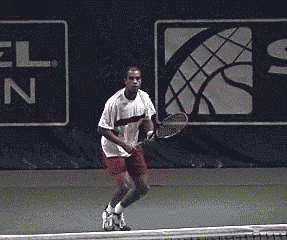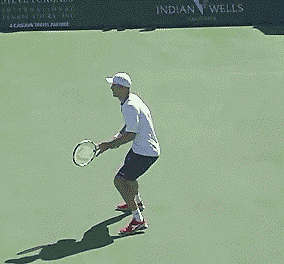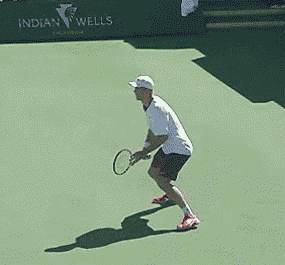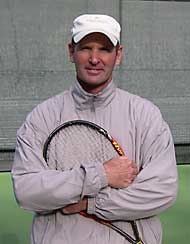|
TennisOne Lessons Relax the Arm and Use the Wrist for Proper Acceleration Doug King page 2 This relaxing of the wrist just prior to contact does not necessarily mean that the wrist is always going to be actively snapped back into contact. In fact most of the time this wrist loosening is a means of letting the arm achieve better acceleration while the wrist itself is allowed to relax so as to better make subtle adjustments to the ball and to achieve a more powerful point of contact in front of the body.
I feel the late flexing back of the racquet, or the delay of the racquet head as the arm is pulled towards the contact of the ball actually builds up tension that is released more in the shoulder than in the forearm. If you look at the video of James Blake, you can see that the racquet is delayed as the butt of the racquet is pulled forward towards contact building up tension throughout the arm and right side of the body. The tension is released and the racquet face squares up to the ball in a quick rotational move. The wrist is held steady (still flexed back through contact) as the shoulder lifts and rotates in a powerful thrust. The arm is held in what appears to be a steady but relaxed position - a kind of "deadweight" feel that allows the arm to stay in good synchronization with the body, much like in the clip of McEnroe on page one. Still this cocking back of the wrist does not preclude the wrist from making positive acceleration into the equation, which we see especially from Nadal and Federer. This can be extremely powerful as the smaller body segments are capable of the most speed, but with that extra power comes additional complications of control and timing. When this kind of positive wrist action is used precision and typically a great deal of spin is required to offset the tremendous force. Grip and Wrist Position at Contact
Another element that factors into the relaxing of the arm and flexing of the wrist is the different responses that can be achieved from various positions between the arm and racquet at contact. If the racquet is held more at a right angle to the forearm, this stretches the tendons in the forearm making them more taut and the racquet less able to recoil at contact. This kind of laid back racquet position associated with a semi-western grip is common to today's competitive players. If the racquet and the forearm are in a straighter alignment, the forearm is more relaxed and the racquet has the ability to recoil more at contact. This straighter alignment between the racquet and the forearm is natural to the Continental grip and will result in a contact point that is further behind and to the side of the body than the more laid back position. This grip is used more for underspin shots and volleys and is more effective in taking speed off of shots. This does not mean that either grip can not be used for either purpose of adding or reducing speed, but only that there are different responses that are naturally associated with the grips.
Learning the Feel Learning to let the arm "unweight" at the top of the backswing and relaxing the wrist and hand to allow a backward flex and rotation is important in developing proper acceleration. To get this feeling hold up a cup of water as though it is the handle of your racquet and then approach a contact and as you do so let the water smoothly our out of the cup behind you. This will help to give you the sensation of how tension drains out of the arm though this backwards rotation of the forearm and relaxation of the wrist. After the cup is empty of water you should be pulling the bottom of the cup towards the imaginary oncoming ball. Then, with a quick rotation and contraction of the core of the body, the final acceleration will bring the hand into proper contact position. Remember, you are trying to get the arm to become deadweight and respond to the explosive drive of the shoulder. The timing of the lay back of the wrist can help to build up more tension and better acceleration of the right side of the body, especially the shoulder. Another exercise is to simply practice with drop hits. Remember you are trying to practice a feeling of letting the arm flow into the ball and the wrist flex back into contact while the shoulder drives and spins the ball. Try not to "hit" or slap the ball with the racquet but instead you should feel as though the hand and racquet "shape onto" and "grip" the ball while the shoulder thrusts, lifts, and contracts in a powerful movement that will both propel and spin the ball. Conclusion Two things I believe are crucial in achieving proper power and acceleration in tennis are things that may not be either intuitive or obvious. One is relaxing the arm, making it become deadweight so that it flows in sync with the body rather than tightening and swinging "forcefully." Forceful does not always mean fast and since tension is designed to restrict movement, a tight forceful swing is usually not a fast swing. Remember to let the arm become more passive to the actions of the hitting side - especially the shoulder action. Secondly is the use of the wrist. Don't try to keep your wrist locked or solid. Instead, learn how to relax the wrist and let it naturally flex back as you approach the ball in a fluid, confident manner. Keep in mind, however, that the laying back of the wrist is to achieve a more powerful position of contact out in front of the body rather than getting the wrist to over tighten or snap into contact. It is also designed to build up tension throughout the entire hitting side of the body, especially the shoulder, which is where you should try to emphasize the acceleration in your stroke while the wrist and racquet are kept more stable. Relaxing the hands and arms will bring fluidity to your play. Timing your wrist will add acceleration to your swing without sacrificing control. The rhythms and feels of an integrated swing that insure the proper flow between the body and the arms require practice. Give these few techniques a try and see if you don't get more acceleration with better control - in many cases they can go hand in hand. Click Here: To return to page 1 Your comments are welcome. Let us know what you think about Doug King's article by emailing us here at TennisOne.
Doug is one of the country's foremost tennis teaching innovators. Founder of Acceleration Tennis, a revolutionary teaching system, King is leading the way in reinterpreting the traditional tennis model. Doug King is currently Director of Tennis at Meadowood Napa Valley ( www.meadowood.com ), a Relaix Chateau Resort in St. Helena , CA . For more information on Acceleration Tennis please email Doug King at dking@meadowood.com. |




 Doug King studied with legendary tennis coach Tom Stow and was a
former California State Men's Singles Champion
and the former number one men's player of Northern California.
Doug King studied with legendary tennis coach Tom Stow and was a
former California State Men's Singles Champion
and the former number one men's player of Northern California.